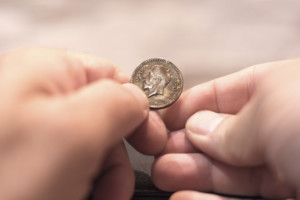Article courtesy of Athens Insider
Where does this tradition come from?
Vasilopita has its origins in various legends, but all are about Saint Basil. According to our favorite version of the tale, as the city of Caesarea lay under siege, Saint Basil called upon the citizens to raise a ransom payment and end the attack. Each citizen gave all they could in gold and jewelry, amazing the enemy with such a great act of collective giving that the siege was called off without even collecting the payment. St. Basil, seeking to return the donated valuables but not knowing what belonged to whom, baked all of the jewelry into loaves of bread and distrusted the loaves to the city. As the legend goes, each citizen miraculously received exactly what they had given, and peace was restored throughout the city.
What is Vasilopita?
Directly translated, vasilopita means “sweet bread of Basil”. Vasilopita bread is prepared with sweet flavoring to symbolize the joy of life everlasting and also the hope that the New Year will be filled with the sweetness of life.
What happens on Vasilopita?
Traditionally, the bread or cake is cut by the head of the household, three times in the shape of the sign of the cross. The first slice is cut for Jesus Christ, the second for the Virgin Mary, and the third for St. Basil. The next slice is cut for the household hosting the celebration, and then a separate piece is cut for each family member and guest in order from eldest to youngest. The final piece is cut for the poor, as a reminder to always share a portion of our gifts with those less fortunate.
The coin
To symbolize the gold and jewels in the origin story of Vasilopita, a gold coin known as the flouri is baked into the bread during its preparation. The individual who receives the slice containing the coin is said to be blessed with good luck in the new year!

Vasilopita recipe (source: Akis Petretzikis)
Ready to host your own Vasilopita party? We’ve got a recipe to help get you started!
Ingredients
• 300 g butter, at room temperature
• 250 g icing sugar
• 1 tablespoon(s) granulated sugar
• 7 g mahlab
• 2 g mastic
• 1/2 teaspoon(s) nutmeg
• 2 tablespoon(s) all-purpose flour
• zest, of 1-2 oranges
• 1 teaspoon(s) vanilla powder
• 4 eggs, at room temperature
• 75 g milk, 3.5%
• 400 g all-purpose flour
• 1 tablespoon(s) baking powder
• Icing sugar
Directions
1. Preheat oven to 180* C (350*F) Fan.
2. In a mixer, beat the butter and icing sugar, with the paddle attachment until light and fluffy. Stop beating and scrape down the sides of the bowl. Beat for another 5 minutes. (It is important that the butter is at room temperature. The softer it is the fluffier your mixture will be.)
3. While you are waiting, add the remaining ingredients from the 1st mixture (apart from the orange zest) and beat them in a blender along with a tablespoon of sugar, until they become powdery. When ready, add the orange zest and mix.
4. Add this powdery mixture to the mixer and beat on low speed.
5. Add all the ingredients from the 2nd mixture, in batches. Release the mixing bowl and add the ingredients from the 3rd mixture. Mix with a large spoon.
6. Grease a round 25 cm spring form baking pan and dust with flour. Transfer the batter to the baking pan.
7. Bake for 45-50 minutes.
8. When ready, remove from oven and dust with icing sugar and serve!
9. If you would like to follow the Greek tradition, wrap a coin and place it somewhere in the cake before you bake it! It will be a Lucky New Year for whichever family member or friend finds it in their slice!
